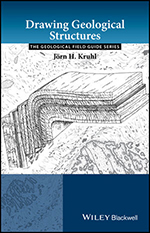11 September 2018
Drawing geological structures, by Jörn Kruhl
Posted by Callan Bentley
 After blogging about geovisualization, reader James Safranek alerted me to this new book about two of my favorite things: drawing and structural geology! I requested a review copy from the publisher, who kindly provided one. It’s great!
After blogging about geovisualization, reader James Safranek alerted me to this new book about two of my favorite things: drawing and structural geology! I requested a review copy from the publisher, who kindly provided one. It’s great!
This is “a whole book” about drawing and geology and specifically structural geology. As such, it’s not going to be as pertinent to every reader as it was to me. But I found it a joy to read, with thoughtful advice about the drawing process (as opposed to the final outcome), our motivations for generating useful geological illustrations, and the specific process to follow when generating certain kinds of images.
To the first point, consider this quote, which is now part of my performance repertoire when I give my geo-visualization talk:
A special merit of drawing is that it requires us to look closely. The click of the camera cannot do this. While we are drawing, we must already geologically assess what we are drawing. Therefore, not just the drawing, but also the path to it, is relevant. Graphical representation — manual drawing — is nothing old-fashioned and superfluous, or just a nice pastime. In the digital age, it is urgently needed, because it teaches us to observe and reflect and it leads to concentration and mindfulness.
Another thing that resonated with me is Kruhl’s comments on “tools,” specifically paper and pen. He doesn’t like lined paper or graph paper, and I wholeheartedly agree. My field notebooks are blank. I even number the pages myself! And I prefer pen to pencil, and so does Kruhl. He lists the importance of consistent line width as one motivation (for as a pencil’s sharp tip is worn down, it creates wider lines), but I also hate the smudginess of ordinary pencils, but I’m also turned off by the dimness of the lines that “hard” pencils leave behind. They don’t smudge, but neither do they really write. I like pen, and Kruhl does too.
Kruhl addresses several kinds of image-making. In particular, I found his comments on drawing thin sections and drawing what he calls “stereograms” (regional structural summaries) to be illuminating. The examples he shows from his own work are nothing short of inspirational. It’s a fun read, and I’m going to have this one within easy reach on my bookshelf for the rest of my career. Recommended!


 Callan Bentley is Associate Professor of Geology at Piedmont Virginia Community College in Charlottesville, Virginia. He is a Fellow of the Geological Society of America. For his work on this blog, the National Association of Geoscience Teachers recognized him with the James Shea Award. He has also won the Outstanding Faculty Award from the State Council on Higher Education in Virginia, and the Biggs Award for Excellence in Geoscience Teaching from the Geoscience Education Division of the Geological Society of America. In previous years, Callan served as a contributing editor at EARTH magazine, President of the Geological Society of Washington and President the Geo2YC division of NAGT.
Callan Bentley is Associate Professor of Geology at Piedmont Virginia Community College in Charlottesville, Virginia. He is a Fellow of the Geological Society of America. For his work on this blog, the National Association of Geoscience Teachers recognized him with the James Shea Award. He has also won the Outstanding Faculty Award from the State Council on Higher Education in Virginia, and the Biggs Award for Excellence in Geoscience Teaching from the Geoscience Education Division of the Geological Society of America. In previous years, Callan served as a contributing editor at EARTH magazine, President of the Geological Society of Washington and President the Geo2YC division of NAGT.